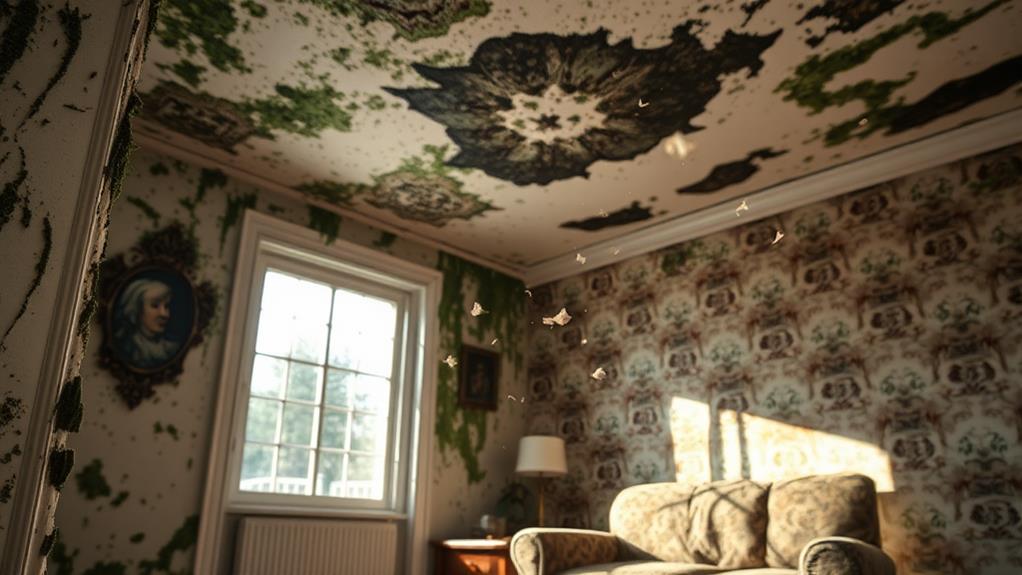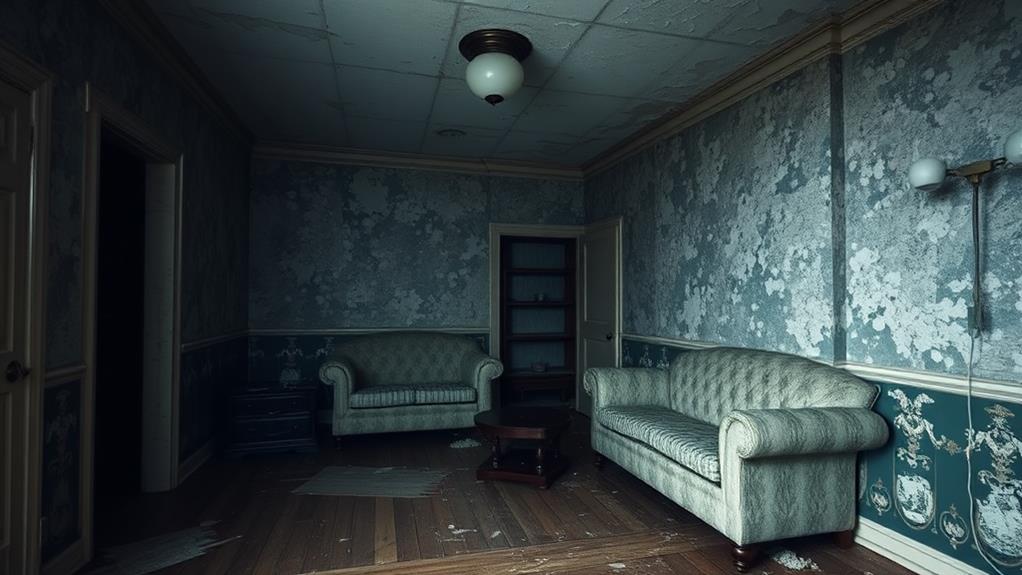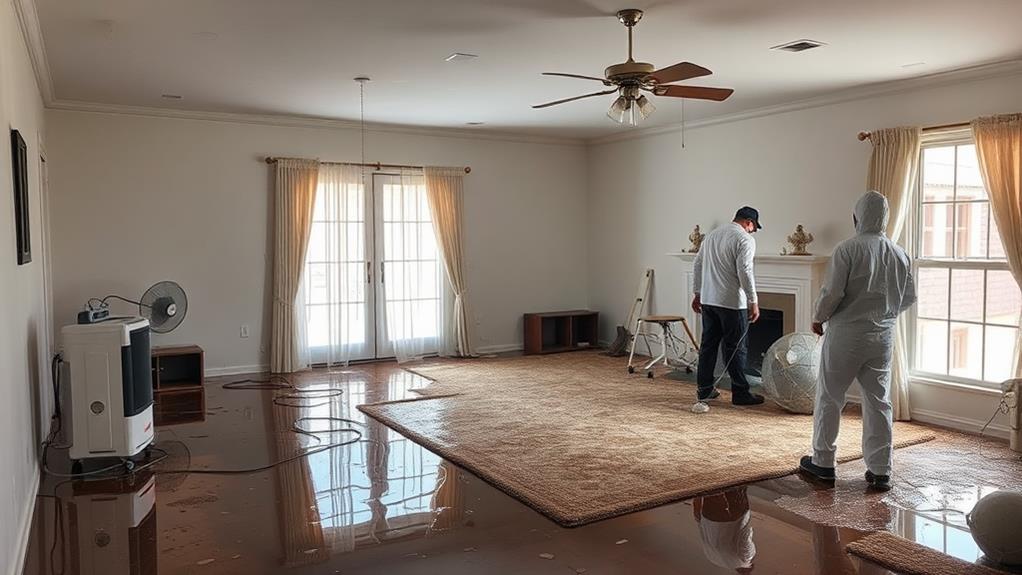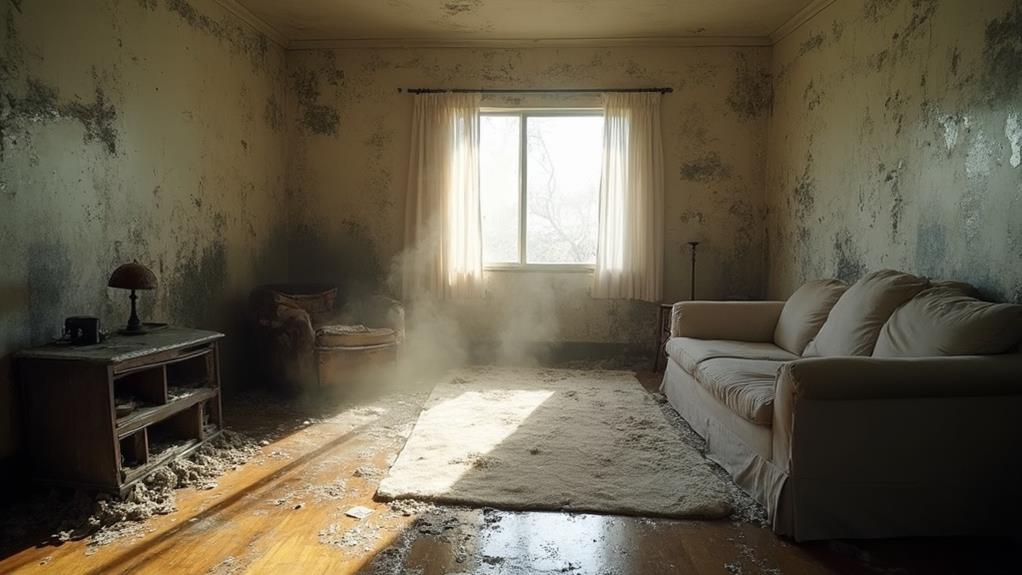Post-flood mold poses significant health risks and property damage. It thrives in water-damaged buildings, reproducing through spores that spread rapidly. Exposure can cause respiratory issues, allergic reactions, and exacerbate pre-existing conditions. Mold deteriorates building materials, weakens structural integrity, and damages personal belongings. Identifying mold early is crucial, as it appears as discolored patches with a musty odor. Prevention strategies include quick water removal, thorough drying, and maintaining low humidity levels. Professional remediation services offer comprehensive solutions for severe infestations. Understanding these dangers empowers homeowners to take swift action and protect their health and property.
What Is Post-Flood Mold?

What exactly is post-flood mold? Post-flood mold refers to the rapid growth of fungi that occurs in water-damaged buildings following a flood event. These microscopic organisms thrive in moist environments and can begin to colonize damp surfaces within 24 to 48 hours after water exposure. The most common types of mold found after floods include Aspergillus, Penicillium, and Stachybotrys chartarum (often called "black mold").
Mold reproduces by releasing spores into the air, which can spread to other areas of the building and settle on various surfaces. As mold colonies grow, they feed on organic materials such as wood, drywall, carpets, and fabrics, causing structural damage and potential health hazards. The presence of post-flood mold is often identified by its musty odor and visible growth, which can appear as discolored patches on walls, ceilings, and floors.
The severity of mold growth depends on factors such as the extent of water damage, humidity levels, and the time elapsed before proper cleanup and drying measures are implemented. Understanding the nature of post-flood mold is crucial for effective prevention and remediation strategies.
Health Risks of Mold Exposure
Mold exposure's health risks can range from mild to severe, depending on various factors such as the individual's susceptibility and the extent of exposure. Common symptoms include respiratory issues like coughing, wheezing, and shortness of breath. Many people experience allergic reactions, manifesting as nasal congestion, eye irritation, and skin rashes.
For individuals with pre-existing respiratory conditions, such as asthma or chronic obstructive pulmonary disease (COPD), mold exposure can exacerbate their symptoms and lead to more serious complications. Immunocompromised individuals are particularly vulnerable to fungal infections caused by certain mold species.
Long-term exposure to mold can result in chronic health problems, including persistent headaches, fatigue, and difficulty concentrating. In rare cases, exposure to toxic molds may lead to neurological symptoms or organ damage.
Children, elderly adults, and pregnant women are considered high-risk groups for mold-related health issues. It's crucial to address mold growth promptly and thoroughly to minimize these health risks. If you suspect mold-related health problems, consult a healthcare professional immediately and take steps to remediate the mold-affected areas in your home or workplace.
Property Damage From Mold Growth

Beyond its health implications, mold growth can cause significant and costly damage to property. Mold thrives in damp environments, making flood-affected areas particularly vulnerable. As mold colonies expand, they can deteriorate various building materials, including drywall, wood, carpets, and insulation.
Mold's destructive nature stems from its ability to break down organic substances for nourishment. This process weakens structural integrity, potentially compromising the safety of buildings. Wood rot, a common consequence of mold infestation, can lead to warped floors, sagging ceilings, and unstable support beams. Drywall and ceiling tiles may become discolored, swollen, or crumble when severely affected.
Mold growth also poses a threat to personal belongings. Furniture, clothing, books, and electronics can all fall victim to mold damage, often rendering them unsalvageable. The cost of replacing these items, combined with structural repairs, can be substantial.
To mitigate property damage, swift action is crucial. Proper drying and dehumidification of flood-affected areas, followed by thorough mold remediation, can help prevent extensive damage and preserve the value of both the building and its contents.
Identifying Mold in Your Home
Recognizing the presence of mold in your home after a flood is crucial for prompt remediation and prevention of further damage. Mold can manifest in various forms, often appearing as discolored patches on walls, ceilings, or floors. Common colors include black, green, brown, or white, and the texture may be fuzzy or slimy.
Visual inspection is the primary method for identifying mold growth. Pay close attention to damp areas, especially those affected by floodwater. Check behind wallpaper, under carpets, and in hidden corners. Mold often thrives in dark, moist environments such as basements, crawl spaces, and attics.
A musty, earthy odor is another telltale sign of mold infestation. If you notice a persistent, unpleasant smell, investigate further to locate its source. Additionally, be aware of any unexplained health symptoms among household members, such as allergic reactions, respiratory issues, or skin irritation, as these may indicate the presence of mold.
For thorough detection, consider using a moisture meter to identify areas of high humidity or hiring a professional mold inspector for a comprehensive assessment of your property.
Prevention Strategies After Flooding

Homeowners can take proactive steps to prevent mold growth after flooding. The first crucial action is to remove standing water and dry out the affected areas within 24-48 hours. Use pumps, wet vacuums, and dehumidifiers to extract water and moisture from floors, walls, and furnishings. Increase air circulation by opening windows and using fans, but ensure they don't spread mold spores to unaffected areas.
Remove and discard porous materials that cannot be thoroughly dried, such as carpets, upholstery, and drywall. Clean and disinfect all surfaces with appropriate antimicrobial solutions. Pay special attention to hidden spaces like crawl spaces, attics, and behind walls where moisture can accumulate.
Monitor humidity levels and keep them below 60% to inhibit mold growth. Consider using mold-resistant products when rebuilding or replacing damaged materials. Inspect and clean HVAC systems to prevent mold from spreading through air ducts. Finally, address any underlying issues that may have contributed to water intrusion, such as poor drainage or foundation cracks, to prevent future flooding and subsequent mold problems.
Professional Mold Remediation Services
While prevention strategies can be effective, extensive mold growth often requires the expertise of professional mold remediation services. These specialists are equipped with advanced tools, protective gear, and specialized knowledge to safely and effectively remove mold infestations.
Professional mold remediation typically involves a comprehensive approach. This includes thorough inspection and assessment of the affected areas, containment to prevent spore spread, air filtration, removal of contaminated materials, and cleaning of salvageable items. Professionals use EPA-approved biocides and fungicides to eliminate mold and prevent its recurrence.
Hiring certified mold remediation experts ensures compliance with industry standards and local regulations. They can identify hidden mold growth, address underlying moisture issues, and provide documentation for insurance claims or property transactions. Additionally, these professionals can implement measures to improve indoor air quality and reduce the risk of future mold problems.
It's crucial to choose a reputable company with proper certifications and experience in post-flood mold remediation. Many offer warranties on their work, providing homeowners with peace of mind and long-term protection against mold-related health risks and property damage.
Frequently Asked Questions
Can Mold Grow in Hidden Areas That Weren't Directly Affected by Flooding?
Yes, mold can grow in hidden areas not directly affected by flooding. Moisture from flood-damaged areas can spread to adjacent spaces, creating favorable conditions for mold growth in concealed locations such as wall cavities, crawl spaces, and attics.
How Long After a Flood Does It Typically Take for Mold to Appear?
Mold can begin to appear within 24 to 48 hours after flooding occurs. However, visible growth may take 3 to 12 days to develop, depending on environmental conditions such as temperature, humidity, and available nutrients.
Are Certain Types of Mold More Dangerous Than Others in Post-Flood Situations?
Certain mold types, such as Stachybotrys (black mold) and Aspergillus, can be more hazardous in post-flood environments. These species produce mycotoxins and can cause severe health issues, particularly for individuals with compromised immune systems or respiratory conditions.
Can Mold Spores Spread to Other Parts of the House Through HVAC Systems?
Silent invaders, visible threats: HVAC systems can indeed facilitate the spread of mold spores throughout a house. These microscopic particles can travel through air ducts, potentially contaminating previously unaffected areas and exacerbating health risks for occupants.
Are Household Pets at Risk From Mold Exposure After a Flood?
Yes, household pets are at risk from mold exposure after a flood. Mold can cause respiratory issues, allergic reactions, and other health problems in animals. Pets may inhale spores or ingest mold while grooming, leading to potential illness.
Conclusion
Mold proliferation after flooding poses significant health and property risks. Swift action is crucial to prevent extensive damage and minimize exposure. Proper identification, prevention strategies, and professional remediation services are key components in addressing post-flood mold issues. Interestingly, studies have shown that mold can begin growing within 24-48 hours of water exposure, emphasizing the urgency of immediate intervention. By understanding the dangers and implementing appropriate measures, individuals and communities can effectively mitigate the impact of mold following flood events.

